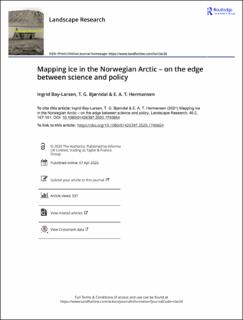| dc.contributor.author | Bay-Larsen, Ingrid Agathe | |
| dc.contributor.author | Bjørndal, Tone Gjesdal | |
| dc.contributor.author | Hermansen, Erlend Andre T. | |
| dc.date.accessioned | 2024-01-30T15:26:23Z | |
| dc.date.available | 2024-01-30T15:26:23Z | |
| dc.date.created | 2020-07-21T10:55:43Z | |
| dc.date.issued | 2020 | |
| dc.identifier.citation | Landscape Research. 2020, . | |
| dc.identifier.issn | 0142-6397 | |
| dc.identifier.uri | https://hdl.handle.net/11250/3114656 | |
| dc.description.abstract | n the Norwegian Arctic, petroleum exploration is prohibited north of the ice edge (the zone between solid sea ice and open ocean); the mapping and definition of the ice edge becomes the boundary for petroleum exploration. However, no evidence-based scientifically ‘correct’ position of the ice edge exists. Defining the ice edge—and its geographic positioning—is the result of co-production processes involving multiple actors and practices. We explore how the use of a new dataset for determining the geographical position of the ice edge became the centre of a proxy debate over how far north petroleum exploration should be allowed. The analysis reveals how maps serve as visual discourses in debate, and a strong correlation between different definitions of the ice edge and political commitment to petroleum activities. We challenge and discuss the performativity of maps and how mismatches between expectations to knowledge-based management, including maps, may have democratic implications. | |
| dc.language.iso | eng | |
| dc.title | Mapping ice in the Norwegian Arctic – on the edge between science and policy | |
| dc.type | Peer reviewed | |
| dc.type | Journal article | |
| dc.description.version | publishedVersion | |
| dc.source.pagenumber | 0 | |
| dc.source.journal | Landscape Research | |
| dc.identifier.doi | 10.1080/01426397.2020.1740664 | |
| dc.identifier.cristin | 1819991 | |
| dc.relation.project | Norges forskningsråd: 268056 | |
| cristin.ispublished | true | |
| cristin.fulltext | original | |
| cristin.qualitycode | 2 | |
